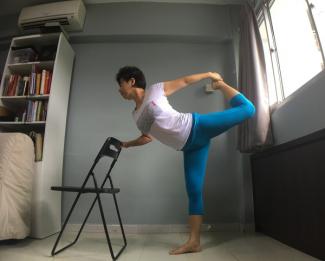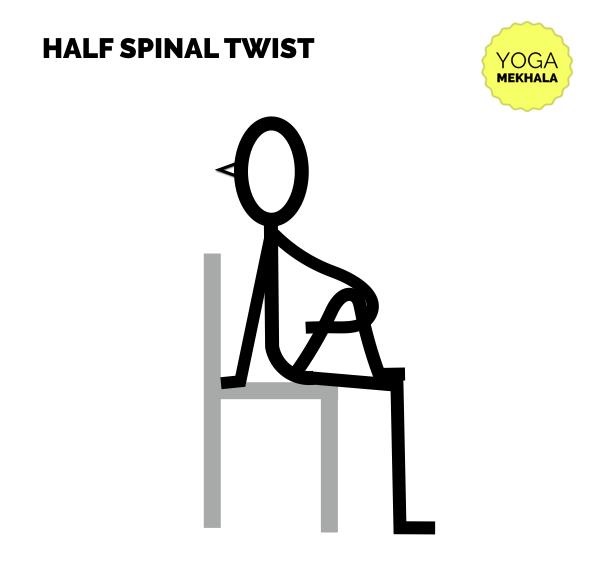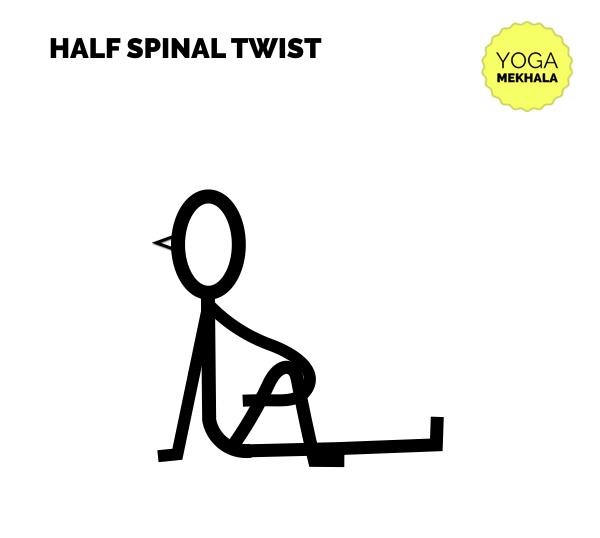
Chair Yoga, a gentle form of yoga that is practiced sitting on a chair or standing using a chair for support, is particularly good for those unable to participate in a traditional yoga class due to the effects of aging or disabilities or for office goers to relax or release tension at the workplace. Mekhala, a Singapore based yoga teacher, guides us through.
Whenever I tell someone that I teach Chair Yoga, besides the regular Mat Yoga, the common reaction is: "Is there such a thing as chair yoga? Haha...."
I have to admit that this was also my reaction during my early days of learning yoga, way before I become a yoga teacher. However, after I began teaching chair yoga, its benefits became more and more apparent to me.
When should you consider Chair Yoga?
Generally chair yoga is suitable for two different categories of students:
- The elderly or people with limited mobility because of injuries
- Office workers
Chair yoga is conducted very differently for these two categories of students. Those with limited mobility may have a much lower fitness level than office workers. Chair yoga will have to be modified to suit their range of stretch. More resting time is given to the senior students. For office workers, chair yoga is very much practised like normal yoga except the poses are modified to be seated on a chair.
For example, see the figure below: the same pose - half spinal twist can be done on either a chair or a mat.


CHAIR YOGA FOR OFFICE WORKERS
A common question is: Why don't we just practise mat yoga as the stretch will be fuller in mat yoga? Why bother with chair yoga?
Yes, you are right. The range of stretch is indeed a lot more in mat yoga. If you have more time to spare, please practise mat yoga. Chair yoga serves the function of making stretches more readily available for busy officer workers. All the stretches or poses taught in a chair yoga class can be used during office hours whenever you need a 5-10 minutes break or stretch from sitting for long hours. The stretches are very useful to relax stiff muscles and joints.
I have also posted some of the office chair yoga classes guide online for my students to refer so that they can practise in the office or at home in their own free time.

Dancer Pose (with chair)
The main function of this pose is to train for balance and for opening of hip joints. At the same time, your upper back and lower back will get a good stretch.
It is important to pay special attention to good grounding of the foot and control the abdomen muscles. These two points will help you tremedously in staying balance.

Locust Pose (with chair)
The main function of this pose is to massage the abdomen (and thus your internal organ, the stomach) and stretch out the entire back. Breath deeply and slowly while holding in the pose.
Chair Yoga for office can engage in much deeper stretch. You can refer to this youtube video for standing forward bend using chair as a support. The details of what to note for can be found at the description of the video.
CHAIR YOGA FOR PEOPLE WITH LIMITED MOBILITY
There are some who find going down and getting up from the floor a huge obstacle. Well, chair yoga is a perfect solution for such cases. I have a couple of classes with seniors who have problems walking. Chair yoga gives them a chance to practise yoga within their ability. In the case where students have problem due to their knees or spine, we practise chair yoga with sitting poses only. Unlike the office chair yoga, we practise some standing pose with the help of the chair too. (See above picture for standing chair yoga pose).
Chair yoga with seniors will focus more on how to gently open up the stiff joints, strengthen the muscles or learn ways to engage the abdominal muscles so that they have a good control of their body while standing up (from a chair). A good control of body motor will ensure less chances of fall during their daily activities.
CHOOSING THE RIGHT CHAIR
When choosing the chair for yoga practise, please take note that you must use a stable and grounded chair. The chair must stand firm on the floor and should be able to take the weight of the yoga practitioner. Avoid roller chairs as much as possible. When seated on the chair, the practitioner must be able to place both feet grounding to the floor. Groundedness is essential for us to find the best balance for the body.
SIVANANDA YOGA
I'm a Sivananda Yoga teacher, therefore all my chair yoga classes are conducted with the same Sivananda Yoga system. We will always practise Pranayama (breathing exercise) at the beginning of the class, followed by Surya Namaskar or Sun Salutation (yes, the series of movements can be modified for chair too) and then we practise various poses or stretches starting from head and neck, slowly moving down towards the spine and torso, finally hips and legs. We end the class with final relaxation. The good news is both pranayama and final relaxation practise have not much of difference whether you practise on a chair or a mat.
On the other hand, breathing and relaxing are skills that most city dwellers lack in. The physical body is visible and thus most people only place importance on ensuring they are well on the outside. However, our mind is actually the most important faculty of a human body. Both breathing and relaxing training are the best tools to teach us how to be more aware. When we have good awareness, we will naturally know how to take good care of our body.
(Mekhala is a Singapore based Sivananda Yoga Teacher and a student of Buddhism. She has been practising Sivananda Yoga since 2007 and Vipassana Meditation since 2009. Find out more on her website or follow her on Facebook and Instagram)
Originally published on 23 July 2017






